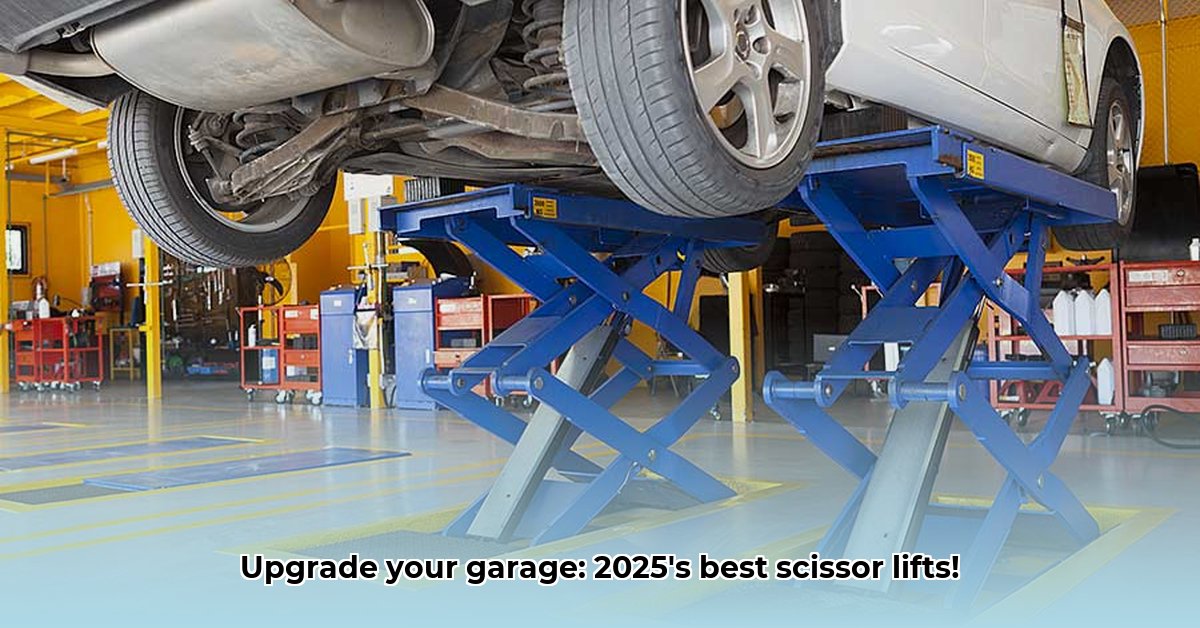
Picking the perfect portable car scissor lift can seem daunting, but this guide simplifies the process. Whether you're a home mechanic or a small shop owner, choosing the right lift is crucial for safety and efficiency. This guide will help you navigate the options and select a lift that meets your specific needs and budget.
Key Factors to Consider When Choosing Your Car Scissor Lift
Several critical factors determine the ideal scissor lift for your needs. Careful consideration of these factors will prevent costly mistakes and ensure your safety.
1. Lifting Capacity: A Weighty Decision
Determining your vehicle's weight is paramount. Never guess—weigh your heaviest vehicle accurately. Choose a lift with a significantly higher capacity than your vehicle's weight to incorporate a crucial safety margin. A lift rated for less weight is dangerous and could result in serious accidents.
2. Lifting Height: How Much Clearance Do You Need?
Lifting height directly impacts your access to the vehicle's undercarriage. Low-rise lifts are space-saving and budget-friendly but offer limited access. Mid-rise lifts are versatile, suitable for most common repairs. Full-rise lifts provide maximum clearance, ideal for extensive work or larger vehicles. Carefully measure your vehicle's height and consider the types of repairs you'll undertake.
3. Portability: Ease of Movement
Portability is essential for smaller garages or frequent relocation. Lighter, more mobile lifts offer convenience, but this often means a lower lifting capacity. Balance the lift's capacity with your need for mobility and consider how often you'll need to move the lift.
4. Open-Center Design: Undercarriage Access
An open-center design provides unrestricted access to the vehicle's undercarriage, crucial for comprehensive repairs. However, these typically require more floor space than closed-center designs. Consider whether complete undercarriage access is essential for your typical maintenance tasks.
5. Flush Mount Option: Maximizing Space
For limited garage space, flush-mount lifts offer a space-saving solution. These lifts recess into the floor, maximizing usable area. While aesthetically pleasing and space-efficient, they usually command a higher price due to increased installation complexity.
Comparative Review of Select Models
This section compares several models to illustrate the decision-making process. Remember, the "best" lift depends entirely on your individual needs. The star ratings below are general impressions and should not substitute detailed manufacturer specifications.
| Model | Lifting Capacity (lbs) | Lifting Height (in) | Portability | Open Center | Flush Mount | Overall Impression |
|---|---|---|---|---|---|---|
| Model A | 7,000 | 54 | ★★★★☆ | ★★★★☆ | ☆☆☆☆☆ | Excellent for heavy vehicles, but limited maneuverability. |
| Model B | 6,000 | 60 | ★★★☆☆ | ★★★★☆ | ★★★★☆ | Good balance of capacity, height, and portability. |
| Model C | 6,000 | 60 | ★★★☆☆ | ★★★★☆ | ★★★★☆ | Similar to Model B, consider feature variations. |
| Model D | 6,000 | 50 | ★★★☆☆ | ★★★★☆ | ☆☆☆☆☆ | Good capacity but lower height may limit applications. |
Actionable Advice Based on User Needs
Matching the right lift to your needs is key:
1. Home Garage Enthusiasts: A mid-rise, portable model suffices for occasional maintenance. Prioritize ease of use and affordability. High capacity and advanced features aren't always necessary for basic tasks.
2. Small Repair Shops: Higher lifting capacity and an open-center design are vital for efficient and comprehensive repairs. Flush-mount options can optimize limited shop space. Consider durability and reliability given the increased usage.
3. Commercial Businesses: Heavy-duty, durable models with high lifting capacities are essential for high-volume use. Prioritize efficiency, minimal downtime, and readily available maintenance and service.
Safety and Regulatory Compliance: A Non-Negotiable Priority
Safety is paramount. Always adhere strictly to the manufacturer’s instructions. Regular inspections and maintenance are crucial to prevent accidents. Comply with all local building codes and safety regulations. Neglecting safety measures can lead to severe injury or even fatality.
Addressing Potential Risks
Proactive risk mitigation is essential:
- Hydraulic System Failure: Regular maintenance, including leak checks, is vital. Address any issues promptly.
- Structural Failure: Purchase from reputable brands offering warranties. Regular inspections are key to catching potential problems early.
- Electrical System Malfunctions: Ensure proper grounding and conduct periodic inspections of electrical components.
- Insufficient Lifting Capacity: Always verify your vehicle's weight. Never exceed the lift's rated capacity.
Conclusion: Choosing Your Perfect Scissor Lift
Selecting the right car scissor lift demands careful consideration. This guide highlights key factors affecting your decision. Thorough research and careful comparison are crucial for making an informed and safe purchase. Prioritizing safety during selection and usage is non-negotiable. Remember that your choice will directly impact safety, efficiency, and the longevity of your maintenance routine.